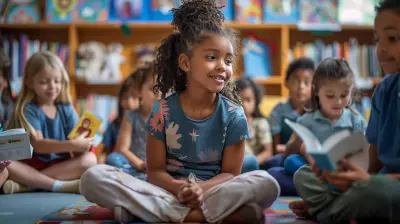The Benefits of Child-Led Learning in Homeschooling
31 August 2025
Ever watched a child utterly engrossed in building a LEGO masterpiece or asking endless ‘what if’ questions about the stars? That, right there, is the raw spark of curiosity—and it's the beating heart of child-led learning. In the world of homeschooling, this approach flips the script on traditional education. Instead of forcing kids to fit into pre-made plans, it gives them a say in what and how they learn.
Pretty neat, right?
Let’s take a deep (and a little mysterious) dive into how this idea works, why it’s winning hearts (and minds), and how it’s transforming homeschooling into something way more magical than most people think.
What Exactly Is Child-Led Learning?
Okay, so before we get carried away, let’s break it down.Child-led learning, also known as interest-led or self-directed learning, lets kids take the wheel of their education. That doesn’t mean parents are just sitting back sipping coffee while the kids run wild (though coffee might still be involved). It means parents become guides, mentors, and co-learners instead of lecturers.
Think of it like this: traditional school is like a train ride—you’re on a fixed track, stopping at predetermined stations. Child-led learning? That’s a road trip with no GPS, just a map, some snacks, and a curious mind navigating toward what excites them.
Pretty freeing, huh?
Why More Homeschooling Parents Are Choosing Child-Led Learning
Homeschooling already breaks out of the usual classroom mold, but child-led learning takes it a step further, tuning into the unique rhythm of each child. Parents are discovering it’s not just more fun—it’s more effective.Here’s why:
1. It Sparks Real, Lasting Curiosity
Ever notice how kids light up when they get to dive into something they truly care about—whether that’s dinosaurs, baking, or ancient Egypt? When learning is driven by curiosity rather than obligation, it sticks.Child-led learning taps into this natural hunger for knowledge. You’re not pouring info into a child; you’re lighting a fire and watching it grow.
2. It Builds Confidence and Independence
Imagine being told what to do and how to do it every day. Now imagine being trusted to make choices and explore your own ideas.Which one helps you grow?
Letting kids make decisions about their learning builds confidence. They feel in control of their education, and that’s a powerful thing. It teaches responsibility, develops self-awareness, and shows them that their opinions and passions matter.
3. It Supports Different Learning Styles
Not every kid learns the same way—some are visual learners, others learn best by doing or through storytelling. In a child-led environment, there's room to adapt.If a child loves drawing, let them illustrate what they’re learning. If they thrive through movement, turn a math lesson into a scavenger hunt. It’s personalized learning on a whole new level.
The Science Backs It Up (Yes, Really)
We’re not just talking warm fuzzies here. Brain science actually supports the way child-led learning works. Neuroscience shows that when people are interested in something, they learn more effectively.Here’s the cool part: curiosity triggers dopamine—the brain’s "feel good" chemical. That dopamine doesn’t just make a kid feel happy; it also enhances the part of the brain responsible for memory formation and learning.
So letting a child follow their interests? It’s basically hacking their brain’s reward system.
Busting the Myth: “But They’ll Never Learn the Basics!”
This one always comes up, right?The fear that if kids aren’t “made” to learn math or grammar, they’ll skip it altogether and end up totally unprepared for real life. But here’s the truth:
Kids are naturally curious about the world. And when they realize they need to use a certain skill to do something they're excited about, they’ll want to learn it.
Want to start a lemonade stand? Suddenly, math is essential. Writing a comic book? Now grammar and storytelling matter.
The basics don’t disappear—they just show up organically, in real-world, meaningful ways.
What Does Child-Led Learning Actually Look Like?
Wondering if this is all a bit too abstract? Let’s zoom in.Picture this:
Your 10-year-old becomes obsessed with space. They build rockets out of cardboard, read books on black holes, and draw constellations on their bedroom ceiling. Together, you watch documentaries, calculate distances between planets, and write stories set on Mars.
That’s astronomy, physics, math, writing, and art—wrapped into one joyful learning experience.
Or maybe your 7-year-old gets fascinated by baking. You dive into recipes (reading comprehension), measure ingredients (math), and talk about the science of yeast (chemistry). Bonus: you get cupcakes out of the deal.
Child-led learning is messy, flexible, and real. And yeah, it can look totally different from day to day.
Real-Life Stories of Child-Led Homeschooling
Still not sure it’s doable?Let’s peek into the lives of real homeschooling families who’ve embraced this path.
Jenny and Her Dinosaur Dig
Jenny, age 9, went from reading dinosaur books to creating an elaborate backyard dig site. She kept a paleontology journal, wrote fictional stories about her “discoveries,” and even taught her siblings a mini-lesson on fossils. Her parents simply provided tools, asked questions, and followed her lead.Result? Jenny learned history, science, writing, research skills—and didn’t even realize it was “school.”
Liam’s YouTube Music Channel
At 12, Liam fell in love with music production. He started composing songs, editing audio, and uploading his work to YouTube. His child-led learning path covered technology, audio engineering, communication, and entrepreneurship. It also gave him a huge confidence boost and a creative outlet.This is learning that means something.
How to Get Started With Child-Led Learning
Okay, so you’re intrigued. Maybe even a little excited. But how do you start?Let’s break it down:
1. Watch and Listen
Notice what sparks your child’s attention. What kind of questions are they asking? What toys, books, or shows do they gravitate toward?Your child’s interests are like breadcrumbs—follow them.
2. Embrace the Rabbit Holes
If your kid becomes obsessed with volcanoes for a week straight, embrace it! Dive deep. Books, videos, field trips—whatever supports their curiosity.Even if it feels repetitive or niche, trust the process. Sometimes these passions lead to broader learning connections later on.
3. Offer, Don’t Force
Provide opportunities and resources, but leave room for choice. Suggest ideas, not assignments.Instead of saying, “You have to write a report on whales,” try, “Hey, would you want to make a poster about your favorite whale species?”
Let them decide how to engage.
4. Redefine “Learning”
Remember, learning doesn’t always look like worksheets or tests. It can be a conversation, a Minecraft build, a nature walk, or a cooking experiment.The magic is in the doing.
When Things Get Tricky: Common Challenges and How to Handle Them
No approach is all sunshine and rainbows. Let’s get real for a second.“My Kid Is Interested in... Nothing?”
That’s okay—sometimes kids need time and space to find their spark. Try exposing them to lots of different activities, topics, and experiences. Curiosity often needs a little ignition.“What About Structure and Routine?”
Child-led doesn’t mean chaos. You can still have rhythms to your day. Think of it as flexible structure—like scaffolding that supports their exploration without pinning them down.“Will They Be Able to Catch Up with Traditional Peers?”
Spoiler alert: They usually do—and in many cases, they surpass them in critical thinking, creativity, and motivation.Because intrinsic motivation beats external pressure any day.
The Hidden Gift: Lifelong Love of Learning
Here’s the kicker.Child-led learning doesn’t just help homeschoolers "get through school." It nurtures a mindset that stays with them for life.
When kids learn to trust their interests, follow curiosity, and seek knowledge on their own, they build a foundation for lifelong learning.
They’re not afraid to ask questions. They don’t wait for someone to hand them the answers. They become thinkers, creators, and change-makers.
Honestly? That’s the kind of education the world needs more of.
Final Thoughts: Letting Go of “Should” and Embracing “Could”
In a world obsessed with test scores, grade levels, and curriculums, child-led learning feels radical. Maybe even risky.But if you've ever seen a child lost in play, deep in thought, or bursting with questions—you’ve already seen it in action.
It starts with trust.
It grows with freedom.
And it blossoms in unexpected, beautiful ways.
So next time you’re tempted to ask, “What should my child be learning today?” try flipping the script and asking:
“What could they be learning if I just let them lead?
all images in this post were generated using AI tools
Category:
HomeschoolingAuthor:

Eva Barker
Discussion
rate this article
1 comments
Maris Kline
Child-led learning empowers students to explore their interests, fostering independence and creativity. It encourages critical thinking and self-motivation, making education more engaging and personalized. This approach can significantly enhance the homeschooling experience for both children and parents.
September 17, 2025 at 2:30 AM

Eva Barker
Thank you for your insightful comment! I completely agree that child-led learning is a transformative approach in homeschooling, promoting independence, creativity, and a personalized educational experience.


